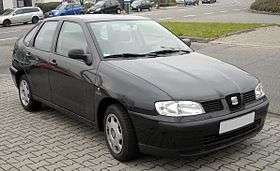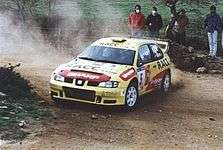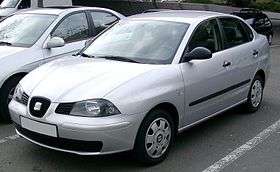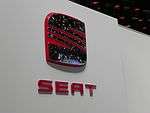SEAT Córdoba
| SEAT Córdoba | |
|---|---|
 1999 SEAT Córdoba Mk1 (facelift) | |
| Overview | |
| Manufacturer | SEAT |
| Production | 1993–2009 |
| Body and chassis | |
| Class | Supermini (B) |
| Platform | Volkswagen Group A0 series |
| Chronology | |
| Predecessor | SEAT Málaga |
| Successor |
SEAT Ibiza ST (wagon) SEAT Toledo (saloon) |
The SEAT Córdoba was the saloon, estate and coupé version of the SEAT Ibiza supermini car, built by the Spanish automaker SEAT. It was manufactured between 1993 and 2009, and was related with the second and third generations of the Ibiza.
First generation (Typ 6K; 1993–2002)
| SEAT Córdoba Mk1 (6K) | |
|---|---|
|
| |
| Overview | |
| Production | 1993–2002 |
| Assembly |
Martorell, Spain Pacheco, Argentina (2000 - 2002) |
| Designer | Giorgetto Giugiaro |
| Body and chassis | |
| Body style |
2-door coupé 4-door saloon 5-door estate |
| Platform | Volkswagen Group A03 |
| Related |
SEAT Ibiza Mk2 Volkswagen Derby Volkswagen Polo Classic Volkswagen Polo Mk3 Volkswagen Golf Mk3 Volkswagen Vento |
| Powertrain | |
| Engine |
1.4 L I4 (petrol) 1.4 L I4 16V (petrol) 1.6 L I4 (petrol) 1.8 L I4 (petrol) 1.8 L I4 16V (petrol) 2.0 L I4 (petrol) 2.0 L I4 16V (petrol) 1.9 L I4 D (diesel) 1.9 L I4 TD (diesel) 1.9 L I4 SDI (diesel) 1.9 L I4 TDI (diesel) |
| Dimensions | |
| Wheelbase | 2,440 mm (96 in) |
| Length | 4,109 mm (161.8 in) |
| Width | 1,640 mm (65 in) |
| Height | 1,408 mm (55.4 in) |
| Curb weight | 990 kg (2,180 lb) |
The first generation Córdoba was presented at the 1993 Frankfurt Motor Show, and launched in the summer of the same year, penned by Italian designer Giorgetto Giugiaro and based on the chassis of the SEAT Ibiza Mk2 which would spawn the Volkswagen Polo Mk3 the following year.
Its 1.4, 1.6, 1.8 and 2.0 litre petrol engines were also found in the Volkswagen Polo and Ibiza, as was the 1.9 TDI.
Though based on the Polo and Ibiza, its extended rear overhang meant its length was close to a Golf but still smaller than the Jetta. It featured a boot space of 455 litres (16.1 cu ft) which could be extended up to 762 litres (26.9 cu ft) by folding rear seats.[1]
Variants
In 1996, the Córdoba range was extended with a coupé (Córdoba SX), and in 1998, with an estate (Córdoba Vario).[2]
The Córdoba SX was a two door coupé version of the Córdoba. It came with five engine variants: 1.6 litre 100 bhp (75 kW; 101 PS), 1.9 litre turbodiesel, a 1.8 litre 16 valve, 2.0 litre 8 valve (Cupra), which was also used in the Córdoba GTi, and a 2.0 litre 16 valve.[2]
The 2.0 litre engines was identical to the engines used in the third generation Golf GTi. The 2.0 litre 16 valve Córdoba SX also came with 16 inch multispoke alloys, 280 mm (11.0 in) front discs, ABS, traction control and air conditioning as standard.
The model was slightly revised in 1996, with a new rear splitter which required the exhaust to be hidden, a revised front lower grill and splitter, and the leather interior which became standard. The Córdoba 16V was £1,000 more expensive at list and one second slower from 0 to 60 mph because of the added weight of the rear end.
Facelift
In August 1999, the Córdoba was facelifted with changes focusing on the bumpers, headlights, taillights and front grille,[2] as well as in the interior, with new materials and upholstery. In the engine range, the 16 valve ABF engine was replaced with a 1.8 litre 156 bhp (116 kW; 158 PS) Turbo engine and joined the Cupra range.[2]
The SX was no longer available in the United Kingdom, and limited numbers are known to exist in the Republic of Ireland in RHD format. The estate variant "Córdoba Vario" dropped the "Cordóba" and now simply used the nameplate "Vario".
Motorsport
Rally
The Córdoba WRC was SEAT's official rally car in the World Rally Championship from 1998 to 2000. It featured a 2.0 litre turbocharged engine. The Córdoba WRC competed in the top category of the championship, as SEAT had homologated a World Rally Car version of the Córdoba 16v for competition in the FIA World Rally Championship and other international rallies. 1994 World Drivers' Champion Didier Auriol, of France, and Toni Gardemeister and Harri Rovanperä, both of Finland, were among those to drive the factory cars.
It made its debut at the 1998 Rally Finland, with Harri Rovanperä as the main driver, and achieved podiums at the 1999 Rally New Zealand, driven by Toni Gardemeister, the 1999 Rally of Great Britain, driven by Rovanperä, as well as in the 2000 Safari Rally, driven by Didier Auriol. The works programme concluded at the end of the season of 2000, with the third evolution of the rally car.
However, the Córdoba WRC continued to compete with successful results in national championships in different countries. In Spain, the Córdoba won the national title of all the rallies on gravel with Pedro Diego and Marc Blázquez, and wins in tarmac rallies with Salvador Cañellas Jr.
Rallycross
A Cordoba has also been used in the FIA World Rallycross Championship. Danish driver Dennis Rømer contested the 2014 World RX of Germany, finishing 40th out of 41 entrants in the heat stage. To date this is, and most likely will remain, the only time a Cordoba has been used in World Championship rallycross, however the SEAT Ibiza has been used as a manufacturer entry.
Rebadged versions
The contemporary Volkswagen Polo Classic (saloon) and Variant (estate) were rebadged versions of the SEAT Córdoba Mk1 and Córdoba Vario respectively, and were not based on the Volkswagen Polo hatchback.
FAW-Volkswagen, Volkswagen's Chinese partner, manufactured the Córdoba Mk1 under the Volkswagen Citi-Golf name between 1997 and 2002.[3] The Citi-Golf had the Córdoba rear and front design (not the European or South American versions), which helped distinguish the Córdoba from the Polo Classic models.
In Mexico it was rebadged as the Volkswagen Derby. In 1995, it was imported from Spain, but the 1996 model was assembled in the Volkswagen de México assembly plant in Puebla, Mexico. In 1998, the Spanish made Polo Classic was introduced in Mexico as the new Volkswagen Derby.
Gallery
_SXE_1.8_sedan_(2015-11-13)_03.jpg) SEAT Córdoba Mk1 (pre facelift)
SEAT Córdoba Mk1 (pre facelift) SEAT Córdoba SX coupé (pre facelift)
SEAT Córdoba SX coupé (pre facelift) SEAT Córdoba Vario estate
SEAT Córdoba Vario estate SEAT Córdoba Mk1 (facelift)
SEAT Córdoba Mk1 (facelift) Daniel Solà with the SEAT Córdoba WRC at the Rallye de tierra de Cangas del Narcea
Daniel Solà with the SEAT Córdoba WRC at the Rallye de tierra de Cangas del Narcea Volkswagen Derby, a rebadged SEAT Córdoba Mk1
Volkswagen Derby, a rebadged SEAT Córdoba Mk1
Engines
| Engine | Code | Type | Displacement | Max. power at rpm | Max. torque at rpm | Top speed | Years | Coupé | Saloon | Estate |
|---|---|---|---|---|---|---|---|---|---|---|
| Petrol engines (Typ 6K; 1992–1999) | ||||||||||
| 1.4 i | ABD | I4 SOHC 8V | 1,391 cc | 60 PS (44 kW; 59 hp) at 5,200 | 107 N⋅m (79 lb⋅ft) at 2,400–2,800 | 145 km/h (90.1 mph) | 1993–1995 | |||
| 1.4 MPI | AEX/APQ | I4 SOHC 8V | 1,390 cc | 60 PS (44 kW; 59 hp) at 4,700 | 116 N⋅m (86 lb⋅ft) at 2,800–3,200 | 145 km/h (90.1 mph) | 1995–1999 | |||
| 1.4 MPI | AFH | I4 DOHC 16V | 1,390 cc | 100 PS (74 kW; 99 hp) at 6,000 | 128 N⋅m (94 lb⋅ft) at 4,400 | 165 km/h (102.5 mph) | 1996–1999 | |||
| 1.6 i | ABU | I4 SOHC 8V | 1,598 cc | 75 PS (55 kW; 74 hp) at 5,200 | 125 N⋅m (92 lb⋅ft) at 3,400 | 155 km/h (96.3 mph) | 1993–1994 | |||
| 1.6 i | 1F | I4 SOHC 8V | 1,595 cc | 75 PS (55 kW; 74 hp) at 5,500 | 125 N⋅m (92 lb⋅ft) at 2,600 | 155 km/h (96.3 mph) | 1994–1997 | |||
| 1.6 MPI | AEE | I4 SOHC 8V | 1,598 cc | 75 PS (55 kW; 74 hp) at 4,800 | 135 N⋅m (100 lb⋅ft) at 2,800–3,600 | 155 km/h (96.3 mph) | 1997–1999 | |||
| 1.6 MPI | Alm/AKS | I4 DOHC 16V | 1,595 cc | 101 PS (74 kW; 100 hp) at 5,800 | 140 N⋅m (103 lb⋅ft) at 3,500 | 165 km/h (102.5 mph) | 1996–1999 | |||
| 1.8 i | ABS/ADZ | I4 SOHC 8V | 1,781 cc | 90 PS (66 kW; 89 hp) at 5,500 | 145 N⋅m (107 lb⋅ft) at 2,700–2,900 | 160 km/h (99.4 mph) | 1993–1996 | |||
| 1.8 MPI | ADL | I4 DOHC 16V | 1,781 cc | 130 PS (96 kW; 128 hp) at 6,000 | 165 N⋅m (122 lb⋅ft) at 4,800 | 195 km/h (121.2 mph) | 1994–1996 | |||
| 2.0 MPI | 2E/AGG | I4 SOHC 8V | 1,984 cc | 116 PS (85 kW; 114 hp) at 5,400 | 165 N⋅m (122 lb⋅ft) at 3,200 (2E)/2,600 (AGG) | 185 km/h (115.0 mph) | 1993–1999 | |||
| 2.0 MPI | ABF | I4 DOHC 16V | 1,984 cc | 150 PS (110 kW; 148 hp) at 6,000 | 180 N⋅m (133 lb⋅ft) at 4,200–5,000 | 210 km/h (130.5 mph) | 1996–1999 | |||
| Petrol engines (Typ 6K2; 1999-2002) | ||||||||||
| 1.0 MPI | ALD/ANV/AUC | I4 DOHC 8V | 999 cc | 50 PS (37 kW; 49 hp) at 5,000 | 86 N⋅m (63 lb⋅ft) at 3,000–3,600 | 145 km/h (90.1 mph) | 1999–2002 | |||
| 1.0 MPI | ||||||||||
| 1.4 MPI | ||||||||||
| 1.4 MPI | ||||||||||
| 1.6 MPI | ||||||||||
| 1.6 MPI | ||||||||||
| 20VT, 1.8T Cupra | ||||||||||
| 1.8T Cupra R | ||||||||||
| Diesel engines (Typ 6K; 1992-1999) | ||||||||||
| 1.9 D | 1Y | I4 SOHC 8V | 1,896 cc | 64 PS (47 kW; 63 hp) at 4,400 | 124 N⋅m (91 lb⋅ft) at 2,000–3,000 | 150 km/h (93.2 mph) | 1993–1999 | |||
| 1.9 TD | AAZ | I4 SOHC 8V | 1,896 cc | 75 PS (55 kW; 74 hp) at 4,200 | 150 N⋅m (111 lb⋅ft) at 2,400–3,400 | 155 km/h (96.3 mph) | 1993–1996 | |||
| 1.9 SDI | AEY | I4 SOHC 8V | 1,896 cc | 64 PS (47 kW; 63 hp) at 4,200 | 125 N⋅m (92 lb⋅ft) at 2,200–2,800 | 150 km/h (93.2 mph) | 1996–1999 | |||
| 1.9 TDI | 1Z/AHU | I4 SOHC 8V | 1,896 cc | 90 PS (66 kW; 89 hp) at 4,000 | 202 N⋅m (149 lb⋅ft) at 1,900 | 160 km/h (99.4 mph) | 1996–1999 | |||
| 1.9 TDI | AFN/AVG | I4 SOHC 8V | 1,896 cc | 110 PS (81 kW; 108 hp) at 4,150 | 235 N⋅m (173 lb⋅ft) at 1,900 | 193 km/h (119.9 mph) | 1996–1999 | |||
| Diesel engines (Typ 6K2; 1999-2002) | ||||||||||
| 1.9 SDI | AGP/AQM | I4 SOHC 8V | 1,896 cc | 68 PS (50 kW; 67 hp) at 4,200 | 133 N⋅m (98 lb⋅ft) at 2,200–2,600 | 161 km/h (100.0 mph) | 1999–2002 | |||
| 1.9 TDI | AGR/ALH | I4 SOHC 8V | 1,896 cc | 90 PS (66 kW; 89 hp) at 3,750 | 210 N⋅m (155 lb⋅ft) at 1,900 | 180 km/h (111.8 mph) | 1999–2002 | |||
| 1.9 TDI | ASK/ASV | I4 SOHC 8V | 1,896 cc | 110 PS (81 kW; 108 hp) at 4,150 | 235 N⋅m (173 lb⋅ft) at 1,900 | 193 km/h (119.9 mph) | 1999–2002 | |||
Second generation (Typ 6L; 2002–2009)
| SEAT Córdoba Mk2 (6L) | |
|---|---|
 | |
| Overview | |
| Production | 2002–2009 |
| Designer | Walter de'Silva |
| Body and chassis | |
| Body style | 4-door saloon |
| Platform | Volkswagen Group A04 (PQ24) |
| Related |
SEAT Ibiza Mk3 Volkswagen Polo Mk4 Škoda Fabia Mk1 Škoda Fabia Mk2 |
| Powertrain | |
| Engine |
1.2 L I3 12v (petrol) 1.4 L I4 16v (petrol) 1.6 L I4 8v (petrol) 1.6 L I4 16v (petrol) 2.0 L I4 8v (petrol) 1.4 L I3 TDI (diesel) 1.9 L I4 SDI (diesel) 1.9 L I4 TDI (diesel) |
| Dimensions | |
| Wheelbase | 2,460 mm (96.9 in) |
| Length | 4,280 mm (168.5 in) |
| Width | 1,698 mm (66.9 in) |
| Height | 1,441 mm (56.7 in) |
| Curb weight | 1,260 kg (2,780 lb) |

The second generation Córdoba was presented at the 2002 Paris Motor Show as the four door saloon version of the SEAT Ibiza Mk3 hatchback, featuring a boot capacity of 485 litres (17.1 cu ft), which could be increased to 800 litres (28 cu ft) by folding the rear seats.[4][5] No estate or coupé versions of the second generation were developed. The Córdoba Mark II shares its chassis and engines with the Volkswagen Polo Mk4 and Škoda Fabia Mk1 and Mk2.
In Mexico, Córdoba production continues in the Volkswagen de México Puebla assembly plant. It has the four cylinder 2.0 litre 115 bhp (86 kW; 117 PS) engine combined with a five speed manual or an optional six speed Tiptronic transmission.
Saloons based on successful hatchbacks very rarely become a sales success in Europe after the turn of the 1990s, and the SEAT Córdoba had done little to change that. It is to SEAT what the Jetta and Vento were to Volkswagen, and what the Belmont was to Vauxhall. This type of car was initially well-received on the British market during the 1980s, with the Escort-based Ford Orion being a strong seller from 1983 and 1990, but its popularity then dipped and it was absorbed into the Escort range from 1993. The saloon version of the Ford Focus only accounted for a small percentage of the model's sales, and by 2011 Ford was not producing a saloon model of this size. Vauxhall/Opel has not produced a saloon version of the Astra since 2004.
In February 2006, the Córdoba was withdrawn from sale in the United Kingdom, and shortly was removed from SEAT UK's official website. In other European countries, sales ended in 2009.
Engines
| Model | Engine code | Max. power | Dates | |||||||
|---|---|---|---|---|---|---|---|---|---|---|
| Petrol engines | ||||||||||
| 1.2 12V | AZQ/BME | 64 hp (48 kW; 65 PS) | 10/02–06/06 | |||||||
| 1.2 12V | BXV | 69 hp (51 kW; 70 PS) | 05/06–11/09 | |||||||
| 1.4 16V | BBY/BKY | 75 hp (56 kW; 76 PS) | 09/02–12/07 | |||||||
| 1.4 16V | BXW | 86 hp (64 kW; 87 PS) | 05/06–11/09 | |||||||
| 1.4 16V | BBZ | 100 hp (75 kW; 101 PS) | 10/02–11/09 | |||||||
| 1.6 8V | BAH | 100 hp (75 kW; 101 PS) | 04/03–11/09 | |||||||
| 1.6 16V | BTS | 105 hp (78 kW; 106 PS) | 11/06–11/09 | |||||||
| 2.0 8V | AZL/BBX | 115 hp (86 kW; 117 PS) | 09/02–11/09 | |||||||
| Diesel engines | ||||||||||
| 1.4 TDI | BNM | 68 hp (51 kW; 69 PS) | 05/05–11/09 | |||||||
| 1.4 TDI | AMF | 75 hp (56 kW; 76 PS) | 10/02–12/05 | |||||||
| 1.4 TDI | BMS/BNV | 80 hp (60 kW; 81 PS) | 05/05–11/09 | |||||||
| 1.9 SDI | ASY | 64 hp (48 kW; 65 PS) | 09/02–12/05 | |||||||
| 1.9 TDI | ATD/AXR/BMT | 100 hp (75 kW; 101 PS) | 09/02–11/09 | |||||||
| 1.9 TDI | ASZ/BLT | 131 hp (98 kW; 133 PS) | 10/02–07/09 | |||||||
Sales and production figures
The total production per year of SEAT Córdoba cars, manufactured in SEAT and other Volkswagen group's plants, is shown in the following table:
| Model | 1998[6] | 1999[6] | 2000[7] | 2001[8] | 2002[9] | 2003[10] | 2004[11] | 2005[12] | 2006[13] | 2007[14] | 2008[15] | 2009[16] |
|---|---|---|---|---|---|---|---|---|---|---|---|---|
| Total annual production | 108,749 | 111,894 | 97,685 | 78,770 | 58,646 | 59,348 | 46,821 | 37,568 | 31,058 | 29,747 | 20,439 | 4,861 |
References
- ↑ "SEAT Cordoba specifications". HobbyAutos.com. Retrieved 19 June 2011.
- 1 2 3 4 "Auto Specificaties - SEAT". Autotrader.nl. Retrieved 19 June 2011.
- ↑ "Volkswagen City-Golf". Histomobile.com. Retrieved 25 September 2010.
- ↑ "Seat revealed the new SEAT Cordoba at Paris Motor Show". Car.kak.net. 26 September 2002. Retrieved 19 June 2011.
- ↑ "Grossansicht Seite 5 von SEAT Cordoba Preisliste" (in German). Produkte24.com. Retrieved 19 June 2011.
- 1 2 "Volkswagen AG Annual Report 1999" (PDF). Volkswagen AG. 27 May 2003. Retrieved 16 September 2010.
- ↑ "Volkswagen AG Annual Report 2000" (PDF). Volkswagen AG. 27 May 2003. Retrieved 16 September 2010.
- ↑ "Volkswagen AG Annual Report 2001" (PDF). Volkswagen AG. 27 May 2003. Retrieved 16 September 2010.
- ↑ "Volkswagen AG Annual Report 2002" (PDF). Volkswagen AG. 27 May 2003. Retrieved 16 September 2010.
- ↑ "Volkswagen AG Annual Report 2003" (PDF). Volkswagen AG. 9 March 2004. Retrieved 16 September 2010.
- ↑ "Volkswagen AG Annual Report 2004" (PDF). Volkswagen AG. 4 March 2005. Retrieved 16 September 2010.
- ↑ "Volkswagen AG Annual Report 2005" (PDF). Volkswagen AG. 1 March 2006. Retrieved 16 September 2010.
- ↑ "Volkswagen AG Annual Report 2006" (PDF). Volkswagen AG. 8 March 2007. Retrieved 16 September 2010.
- ↑ "Volkswagen AG Annual Report 2007" (PDF). Volkswagen AG. 10 March 2008. Retrieved 16 September 2010.
- ↑ "Volkswagen AG Annual Report 2008" (PDF). Volkswagen AG. 7 April 2009. Retrieved 16 September 2010.
- ↑ "Volkswagen AG Annual Report 2009" (PDF). Volkswagen AG. 22 March 2010. Retrieved 16 September 2010.
External links
| Wikimedia Commons has media related to SEAT Córdoba. |
| Type | 1980s | 1990s | 2000s | 2010s | ||||||||||||||||||||||||||||||||||
| 0 | 1 | 2 | 3 | 4 | 5 | 6 | 7 | 8 | 9 | 0 | 1 | 2 | 3 | 4 | 5 | 6 | 7 | 8 | 9 | 0 | 1 | 2 | 3 | 4 | 5 | 6 | 7 | 8 | 9 | 0 | 1 | 2 | 3 | 4 | 5 | 6 | 7 | |
| City car | Panda | Marbella | Arosa | Mii | ||||||||||||||||||||||||||||||||||
| Supermini | 127 | Ibiza I | Ibiza II | Ibiza III | Ibiza IV | Ibiza V | ||||||||||||||||||||||||||||||||
| Fura | Córdoba I | Córdoba II | Toledo IV | |||||||||||||||||||||||||||||||||||
| Small family car | Ritmo | Ronda | León I | León II | León III | |||||||||||||||||||||||||||||||||
| 131 | Málaga | Toledo I | Toledo II | |||||||||||||||||||||||||||||||||||
| Large family car | 132 | Exeo | ||||||||||||||||||||||||||||||||||||
| Compact MPV | Altea / Altea XL / Altea Freetrack / Toledo III | |||||||||||||||||||||||||||||||||||||
| Large MPV | Alhambra I | Alhambra II | ||||||||||||||||||||||||||||||||||||
| Mini SUV | Arona | |||||||||||||||||||||||||||||||||||||
| Compact SUV | Ateca | |||||||||||||||||||||||||||||||||||||
| Van | Trans | Terra | Inca | |||||||||||||||||||||||||||||||||||
| ||||||||||||||||||||||||||||||||||||||
